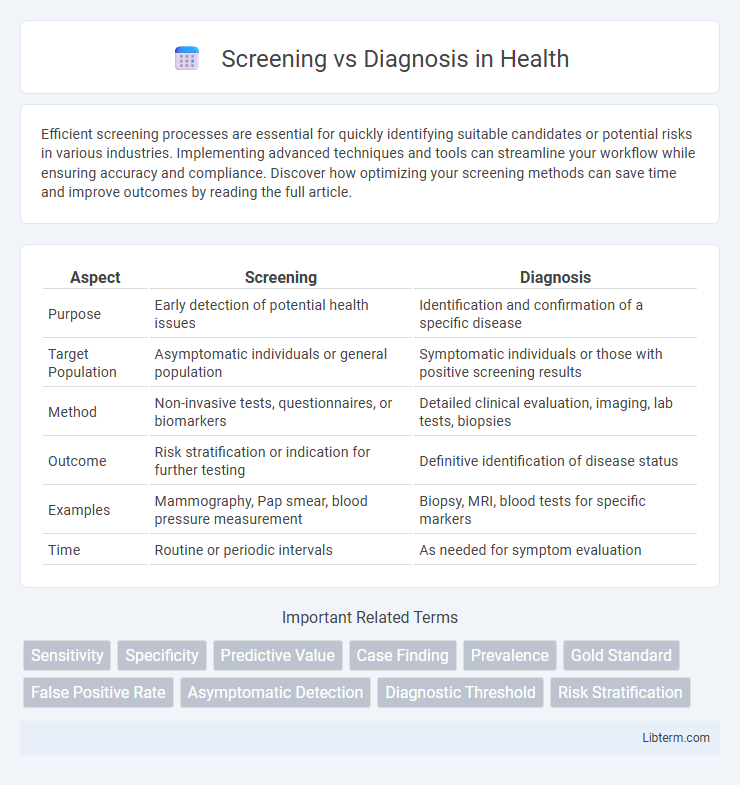Efficient screening processes are essential for quickly identifying suitable candidates or potential risks in various industries. Implementing advanced techniques and tools can streamline your workflow while ensuring accuracy and compliance. Discover how optimizing your screening methods can save time and improve outcomes by reading the full article.
Table of Comparison
| Aspect | Screening | Diagnosis |
|---|---|---|
| Purpose | Early detection of potential health issues | Identification and confirmation of a specific disease |
| Target Population | Asymptomatic individuals or general population | Symptomatic individuals or those with positive screening results |
| Method | Non-invasive tests, questionnaires, or biomarkers | Detailed clinical evaluation, imaging, lab tests, biopsies |
| Outcome | Risk stratification or indication for further testing | Definitive identification of disease status |
| Examples | Mammography, Pap smear, blood pressure measurement | Biopsy, MRI, blood tests for specific markers |
| Time | Routine or periodic intervals | As needed for symptom evaluation |
Understanding Screening and Diagnosis
Screening involves identifying potential health issues in asymptomatic individuals through tests or assessments, aiming to detect diseases early for effective intervention. Diagnosis confirms the presence and specifics of a disease by thorough evaluation, including clinical examination, medical history, and diagnostic tests. Understanding screening's role in early detection versus diagnosis's function in definitive disease identification is crucial for effective medical management and treatment planning.
Key Differences Between Screening and Diagnosis
Screening involves the preliminary identification of potential health issues in asymptomatic individuals using tests designed for early detection, while diagnosis confirms the presence of a specific disease through detailed evaluation and clinical assessment. Screening tests are typically less invasive, cost-effective, and applied to large populations, whereas diagnostic procedures require more precise, often invasive methods to establish definitive clinical evidence. The key difference lies in purpose: screening aims to flag possible conditions early, and diagnosis aims to validate and characterize the condition for appropriate treatment planning.
Purpose and Goals of Screening
Screening aims to identify individuals at risk of a specific disease or condition in asymptomatic populations to enable early intervention and reduce disease burden. The primary goal of screening is to detect potential health issues before symptoms appear, facilitating timely treatment and improving prognosis. By targeting high-risk groups, screening programs enhance public health outcomes through prevention and early detection efforts.
Purpose and Goals of Diagnosis
Diagnosis aims to identify the specific nature and cause of a medical condition to guide appropriate treatment decisions. It involves comprehensive evaluation, including clinical tests, patient history, and symptom analysis, to confirm a disease or disorder. The primary goal is to provide an accurate and definitive understanding of the patient's health status for targeted intervention.
Common Methods Used in Screening
Common methods used in screening include blood tests, imaging techniques such as mammography and ultrasound, and physical examinations designed to detect early signs of diseases. These methods aim to identify potential health issues in asymptomatic individuals, facilitating timely intervention. Screenings like Pap smears, colonoscopies, and blood pressure measurements are widely deployed to reduce disease burden through early detection.
Diagnostic Procedures and Techniques
Diagnostic procedures focus on confirming the presence or absence of a specific disease through detailed testing methods such as biopsy, imaging studies like MRI or CT scans, and laboratory analyses including blood tests and molecular diagnostics. Screening involves preliminary assessments designed to identify individuals at risk of a condition, often using less invasive techniques like questionnaires, blood pressure measurement, or mammography. Accurate diagnosis relies on combining clinical evaluation with advanced techniques to ensure precise disease characterization and appropriate treatment planning.
When to Use Screening vs Diagnosis
Screening is used for early detection in asymptomatic individuals to identify potential health risks before symptoms appear, often applied in large populations for conditions like cancer or diabetes. Diagnosis occurs when a patient presents symptoms or has a positive screening result, involving specific tests to confirm or rule out a disease. Screening is preventive and broad, while diagnosis is confirmatory and targeted, guiding clinical decisions and treatment plans.
Benefits and Limitations of Screening
Screening offers the benefit of early detection for diseases in asymptomatic individuals, enabling timely intervention and improving overall prognosis. Limitations include the risk of false positives or negatives, which can lead to unnecessary anxiety, additional testing, or missed diagnoses. Screening is not diagnostic and requires follow-up tests to confirm the presence of a condition.
Benefits and Limitations of Diagnosis
Diagnosis provides precise identification of a disease or condition, allowing targeted treatment plans and improving patient outcomes through tailored interventions. Limitations include the potential for false negatives or positives, diagnostic errors due to overlapping symptoms, and the need for specialized tests that might be costly or invasive. Accurate diagnosis remains critical for effective management but must be interpreted within clinical context and patient history to minimize risks and enhance reliability.
Screening and Diagnosis in Preventive Healthcare
Screening in preventive healthcare involves systematic testing of asymptomatic individuals to detect potential health disorders early, thereby enabling timely intervention and reducing disease progression. Diagnosis follows screening when a test result indicates the presence of a condition, confirming the disease through comprehensive evaluation and clinical assessment. Effective screening programs enhance population health outcomes by facilitating early diagnosis and management of chronic diseases such as cancer, diabetes, and cardiovascular conditions.
Screening Infographic

 libterm.com
libterm.com